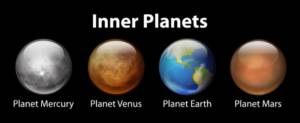Signs, Stars, and the Self: The Inner Planets in Modern Astrology

To understand how astrology works, it’s important to first learn about the planets’ positions and meanings, including the inner planets.
Astrology is everywhere. You likely already know your “sign,” but there’s far more to this divination method than that. To understand how astrology works, it’s important to first learn about the planets’ positions and meanings. Astrologers believe that the inner planets, located between our sun and the solar system’s asteroid belt, divulge a lot about an individual’s personality.
What Are the Inner Planets?
When reading an individual’s chart, astrologers often begin with the inner planets. Astrostyle describes these as faster-moving celestial bodies thought to impact our moods, habits, and daily lives. The inner planets include the Sun and Moon along with Mercury, Venus, and Mars. When discerning an individual’s temperament, personality makeup, and immediate future trends, astrologers focus on these inner planets.
Your Sun Sign: Your Core Self
When someone asks, “what’s your sign,” they’re referring to the zodiac constellation in which the Sun was present when you were born. Mystica Astrology’s Emma Wilson describes it as symbolic of our search for self-identity and self-knowledge as well as who an individual is on an archetypal level. The Astro Codex adds that the Sun corresponds with our personalities and egos. Our sun stays in each zodiac sign for about 30 days.
The Moon: Emotions and the Soul
With astrology’s popularity, more people know their moon signs. Astrostyle explains that the Moon’s position in a constellation speaks to our emotions, subconscious minds, and deepest needs. Emma Wilson elaborates that it also reveals our vulnerabilities and what we need to feel secure. Since the Moon takes two to three days to move through a zodiac sign, you must know the exact time of an individual’s birth to determine the Moon sign.
Mercury: Communication, Logic, and Reason
Named for the Roman messenger of the gods, Mercury is a key player in each person’s natal chart. The Astro Codex mentions that this planet represents the human mind. Its position in the zodiac reflects how we think, reason, and communicate. With an orbital period of only 88 days, Mercury takes between three and four weeks to travel through each zodiac constellation.
Venus: Love, Pleasure, and Attraction
Venus is said to be the planet of love. Associated with the Roman goddess of love and beauty, it’s no wonder Emma Wilson says it’s symbolic of “who and what you are drawn towards.” Although commonly linked with romantic love and sexuality, Venus also points to our indulgences and preferences in everything from art to politics. Traveling around the Sun in 225 days, Venus’s orbit is somewhat elliptical. As a result, it can move through each sign in about 20 to 30 days.
Mars: Action, Energy, and Drive
The Astro Codex calls Mars a “vital force,” speaking to its association with the Roman god of war. Our Mars placements can indicate how competitive we are, where we focus our energies, and how we strive to meet our goals. Unsurprisingly, Mars is also thought to govern our sex drives and raw attraction. Mars’s orbit around the Sun lasts 687 days, so it normally traverses each sign in about 90 days.
Where Can I Get My Birth Chart?
By now, you may be wondering where all these planets are positioned in your natal chart. Fortunately, you don’t have to be a professional astrologer to access this information. CBC contributor Rebecca Perrin lists several websites where you can obtain your birth chart for free, using the same technology as most astrology software programs. Some show only your natal chart, while others also offer either brief interpretations or extensive details.
Astrology has been with us for thousands of years. Thanks to the internet, you can easily find resources for obtaining and understanding your natal chart. Starting with the inner planets, you can begin to comprehend the complex details that astrologers believe are at work in making up your personality and life.

